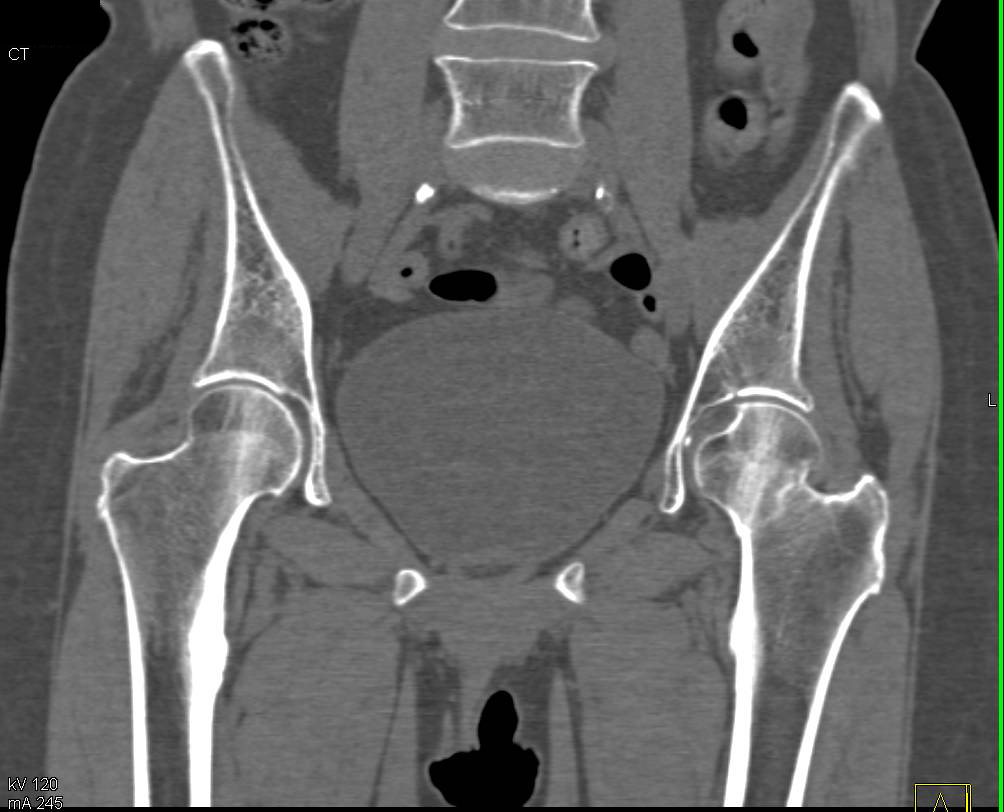

Circulation to parts of the lungs is cut off which can be very dangerous. A pulmonary embolism (PE) occurs when clotted blood from a DVT comes loose from the leg veins and passes up to the lungs. This is very common after hip fracture as the circulation is stagnant and the blood is hypercoagulable as a response to injury. Deep venous thrombosis (DVT) is when the blood in the leg veins clots and causes pain and swelling. Hip fracture patients are at considerable risk for thromboemoblism, blood clots that dislodge and travel in the bloodstream. Nevertheless, the stress of the injury, and a likely surgery, increases the risk of medical illness including heart attack, stroke, and chest infection. Many people are unwell before breaking a hip it is common for the break to have been caused by a fall due to some illness, especially in the elderly. Hip fractures rarely result in neurological or vascular injury. This may not be as much of a concern in patients with limited independence and mobility. Shortening, varus deformity, valgus deformity, and rotational malunion all occur often because the fracture may be unstable and collapse before it heals. The thigh muscles tend to pull on the bone fragments, causing them to overlap and reunite incorrectly. Malunion, healing of the fracture in a distorted position, is very common. Avascular necrosis of the femoral head occurs frequently (20%) in intracapsular hip fractures, because the blood supply is interrupted. Nonunion, failure of the fracture to heal, is common in fractures of the neck of the femur, but much more rare with other types of hip fracture. On examination, the affected extremity is often shortened and externally rotated compared to the unaffected leg. Pain may be referred to the supracondylar knee.

The classic clinical presentation of a hip fracture is an elderly patient who sustained a low-energy fall and now has groin pain and is unable to bear weight. The affected extremity is often shortened and unnaturally, externally rotated compared to the unaffected leg The risk of death in the year following a fracture is about 20% in older people. Hip fractures become more common with age. Ībout 15% of women break their hip at some point in life women are more often affected than men. Treatment to prevent blood clots following surgery is recommended. Options for surgery may include a total hip replacement or stabilizing the fracture with screws. If the person's health allows, surgery is generally recommended within two days. Pain management may involve opioids or a nerve block. Magnetic resonance imaging, a CT scan, or a bone scan may occasionally be required to make the diagnosis. ( Femoral head fractures are a rare kind of hip fracture that may also be the result of a fall but are more commonly caused by more violent incidents such as traffic accidents.) Risk factors include osteoporosis, taking many medications, alcohol use, and metastatic cancer. Such fractures most often occur as a result of a fall. Ī hip fracture is usually a femoral neck fracture. Symptoms may include pain around the hip, particularly with movement, and shortening of the leg. ~20% one year risk of death (older people) Ī hip fracture is a break that occurs in the upper part of the femur (thigh bone), at the femoral neck or (rarely) the femoral head. Improved lighting, removal of loose rugs, exercise, treatment of osteoporosis Osteoarthritis, avascular necrosis of the hip, hernia, trochanteric bursitis Osteoporosis, taking many medications, alcohol use, metastatic cancer Intracapsular, extracapsular (intertrochanteric, subtrochanteric, greater trochanteric, lesser trochanteric) Pain around the hip particularly with movement, shortening of the leg Intertrochanteric hip fracture in a 17-year-old male Proximal femur fracture femoral neck fracture femoral head fracture


 0 kommentar(er)
0 kommentar(er)
